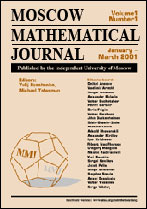|
This article is cited in 5 scientific papers (total in 5 papers)
Periodic Schrödinger operators and Aharonov–Bohm Hamiltonians
B. Helffera, T. Hoffmann-Ostenhofb, N. S. Nadirashvilic
a Paris-Sud University 11
b International Erwin Schrödinger Institute for Mathematical Physics
c University of Chicago
Abstract:
Let $H=-\Delta+V$ be a two-dimensional Schrödinger operator defined on a domain $\Omega\subset\mathbb R^2$ with Dirichlet boundary conditions. Suppose that $H$ and $\Omega$ are that $V(x_1,x_2)=V(-x_1,x_2)$ and that $(x_1,x_2)\in\Omega$ implies $(x_1+1,x_2)\in\Omega$ and $(-x_1,x_2)\in\Omega$. We investigate the associated Floquet operator $H_(q)$, $0\leq 1$. In particular, we show that the lowest eigenvalue $\lambda_q$ is simple for $q\neq 1/2$ and strictly increasing in $q$ for $0<q<1/2$ and that the associated complex-valued eigenfunction $u_q$ has empty zero set. For the Dirichlet realization of the Aharonov–Bohm Hamiltonian in an annulus-like domain with an axis of symmetry,
$$H_{A,V}=(i\partial_{x-1}+ A_1)^2+(i\partial x_2+A_2)^2+V$$
, we obtain similar results, where the parameter $q$ is replaced by the $\frac{1}{2\pi}$-flux through the hole, under the assumption that the magnetic field curl $A$ vanishes identically.
Key words and phrases:
Schrödinger operator, magnetic field, eigenvalues.
Received: May 7, 2002
Citation:
B. Helffer, T. Hoffmann-Ostenhof, N. S. Nadirashvili, “Periodic Schrödinger operators and Aharonov–Bohm Hamiltonians”, Mosc. Math. J., 3:1 (2003), 45–61
Linking options:
https://www.mathnet.ru/eng/mmj75 https://www.mathnet.ru/eng/mmj/v3/i1/p45
|

| Statistics & downloads: |
| Abstract page: | 335 | | References: | 72 |
|




 Contact us:
Contact us: Terms of Use
Terms of Use
 Registration to the website
Registration to the website Logotypes
Logotypes








 Citation in format
Citation in format 
